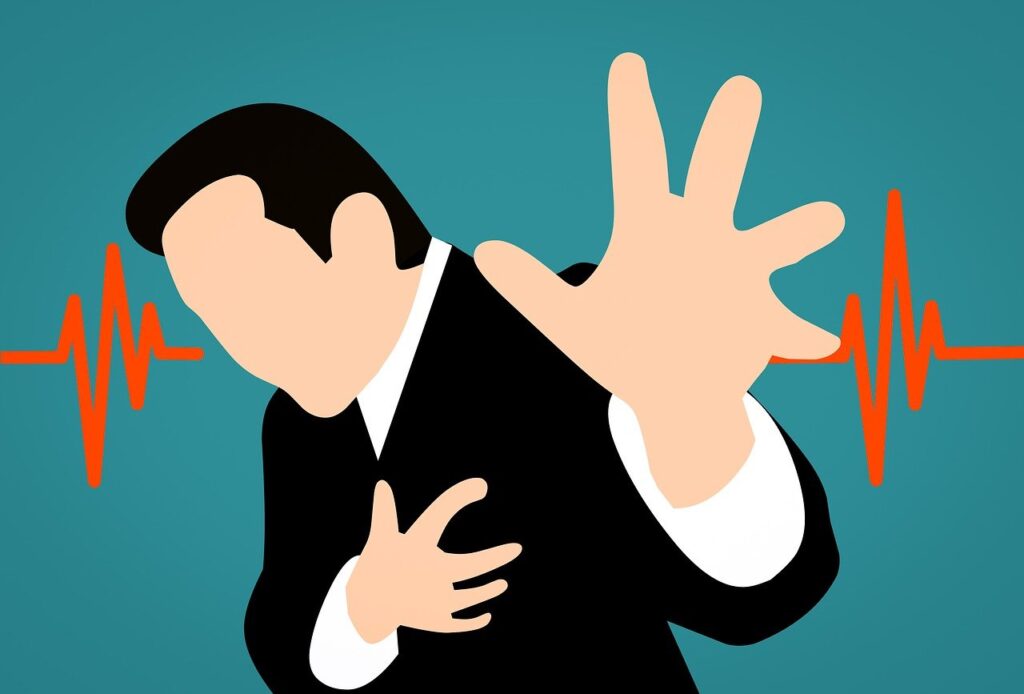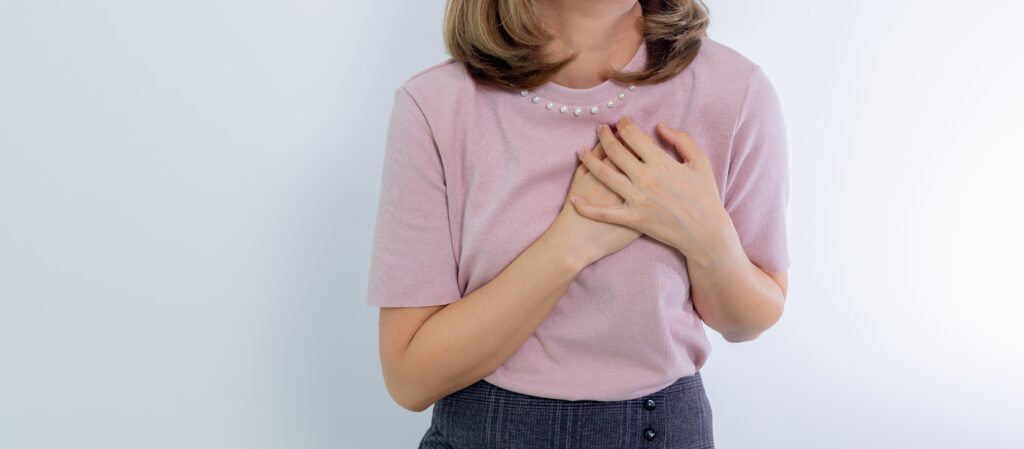Costochondritis symptoms will come as a result of inflammation in the cartilage that connects your ribs to the sternum (breastbone). It can manifest itself with a wide range of symptoms, impacting various parts of the body. Let me explore the diverse symptoms associated with costochondritis for you to provide insights into the nature of this condition.
1. Sharp Chest Pain- The Hallmark Symptom
The most prominent and typical symptom of costochondritis is dull chest pain. The chest pain occurs in front of the chest close to the meeting point of the ribs and breastbone. This chest pain often termed left-hand side chest pain occurs on the left side of your chest with a possibility of spreading to your back and belly. This pain is often described as sharp, and localized, is usually situated near the sternum, and is often referred to as sternum pain. It can be mistaken for cardiac-related chest pain, but it tends to be more focal.
2. Movement-Induced Pain
Costochondritis pain is distinct in that it intensifies with movement. Activities like bending, twisting, coughing, sneezing, and deep breaths can exacerbate the discomfort. This characteristic helps distinguish costochondritis from other types of chest pain causes.
3. Tenderness When Your Rib Joints are Touched
This is another distinguishing costochondritis symptom from other types of chest pains. You feel pain when you or someone touches your ri joints because they are tender and fragile.
4. Right-Side and Left-Side Symptoms
Costochondritis is not limited to one side of the chest. It can affect either the right or left side of the chest, and in some cases, both sides simultaneously. This variability can complicate costochondritis symptoms diagnosis.
5. Radiating Pain: Back, Neck, Arms, and Armpits
In certain instances, costochondritis can lead to radiating pain, affecting areas such as the back, neck, arms, or armpits. This feature can be disconcerting and sometimes leads to misdiagnosis as other musculoskeletal or cardiovascular conditions.
6. Breathing Difficulties
Costochondritis can also interfere with comfortable breathing. If you are affected, you will feel pain when taking a deep breath or when you are coughing. The pain subsides when you stop moving or when you start breathing more quietly. Some individuals experience shortness of breath or difficulty taking deep breaths due to the pain, which can be quite distressing.
7. Atypical Symptoms
Costochondritis may present with atypical symptoms, further complicating diagnosis. These unusual manifestations can include dizziness, heart palpitations, headaches, and heartburn. These atypical symptoms may divert attention from the primary condition.
8. Chronic and Acute symptoms
Costochondritis can either come with acute or chronic symptoms. Acute symptoms are shorter in duration, while chronic cases persist over an extended period, sometimes spanning years. This distinction can significantly impact the quality of life if you are affected.
9. Pediatric and Pregnancy-Related Symptoms
Costochondritis is not exclusive to adults. Your children can develop this condition, and it can occasionally emerge during your pregnancy, particularly due to the physical changes that occur in your body during this time.
Critical Costochondritis Symptoms
These are costochondritis symptoms that will warrant seeing your healthcare physician as soon as possible. This is because they are lethal and if not treated immediately, they can make your situation worse:
- Difficulty in your breathing
- Abnormally high temperatures
- A Feeling of dizziness
- Nausea symptoms
- Profuse sweating
- Continuous or worsening chest pain
- Sweating at your joints
Costochondritis Causes
The exact cause of costochondritis has remained unknown in many studies. However, several factors may contribute to its development, including:
- Infections: Bacterial or viral infections can sometimes trigger costochondritis.
- Trauma: Direct chest injuries or blows can lead to this condition.
- Repetitive Movements: Activities involving repeated chest motions can increase the risk.
- Underlying Conditions: If you are living with conditions like fibromyalgia, lupus, or allergies may be more prone to developing costochondritis.
Costochondritis Symptoms Self-Care
If you’re experiencing costochondritis symptoms, what should you do and avoid as you seek medical intervention? Here is a list of do’s and don’ts immediately after experiencing any of the costochondritis symptoms:
- For ladies, sleep with a lightweight bra at night to reduce the pressure on your breasts
- If you are a smoker, avoid smoking because smoking makes the inflammation worse
- Soothe your painful chest using warm watery pads
- Avoid moving fast or any vigorous activity that aggravates the chest pain
Woman Costochondritis Pain Areas
Costochondritis typically causes chest pain and tenderness in specific areas around the chest wall. In women, as in men, the pain tends to manifest in similar regions:
- Upper Chest: Pain often occurs near the sternum (breastbone) or the ribcage’s upper portion.
- Sides of the Chest: Discomfort might extend to the sides of the chest, particularly where the ribs connect to the breastbone.
- Breastbone Area: Tenderness and pain can be felt directly over the breastbone or along the cartilage that connects the ribs to the breastbone.
- Between Ribs: Pain might be localized in the spaces between the ribs where the cartilage is inflamed.
- Shoulder and Upper Back: Some individuals with costochondritis might experience referred pain, where discomfort from the chest area radiates to the shoulders or upper back.
- Arm and Ribcage: Occasionally, pain can extend along the ribcage or down the arm, particularly on the same side as the affected area of inflammation.
- Muscle and Tissue Sensitivity: Women might also experience increased sensitivity or discomfort in the muscles and tissues around the chest due to the body’s response to the inflammation.
How do You Diagnose Costochondritis?
Diagnosing costochondritis symptoms involves a comprehensive medical evaluation. Your healthcare professional relies on your medical history, a physical examination, and sometimes diagnostic tests such as X-rays to rule out other conditions that may mimic costochondritis.
What Foods Trigger Costochondritis?
Costochondritis, as an inflammatory condition affecting the cartilage connecting the ribs to the breastbone, isn’t typically triggered by specific foods. However, some individuals might find that certain foods or dietary factors exacerbate inflammation or contribute to discomfort associated with musculoskeletal conditions like costochondritis.
Conclusion
Costochondritis is a condition with a broad spectrum of symptoms primarily centered around sharp chest pain. These symptoms can vary in terms of location, intensity, and duration. By recognizing these symptoms and seeking professional medical evaluation, you stand a chance for an accurate diagnosis and effective management of costochondritis. If you suspect that you have costochondritis or are experiencing any of the symptoms discussed, I can only advise you to consult your healthcare provider for guidance and tailored treatment options.
Visit www.medicalantidote.com for more health resources.



